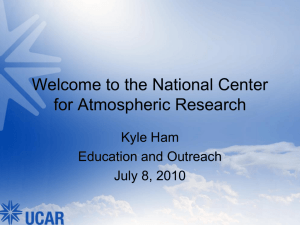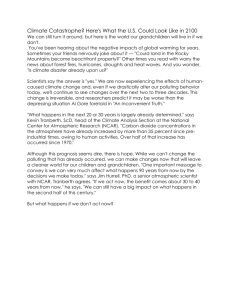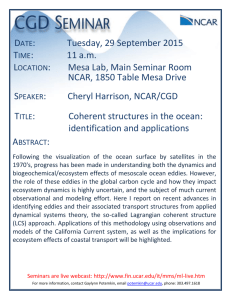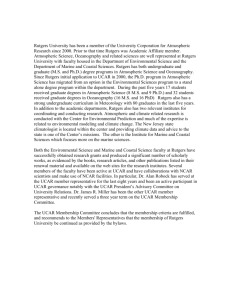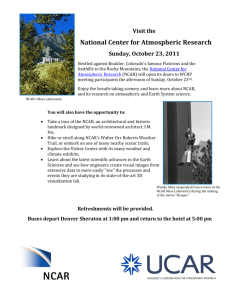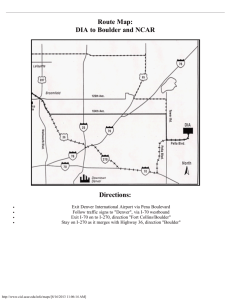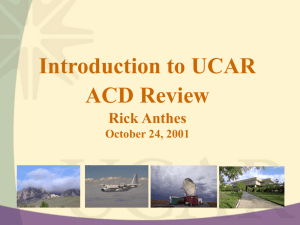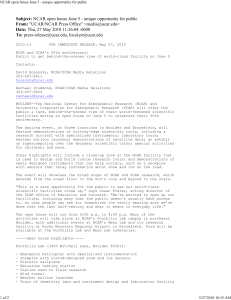FellowsMSU - Michigan State University
advertisement
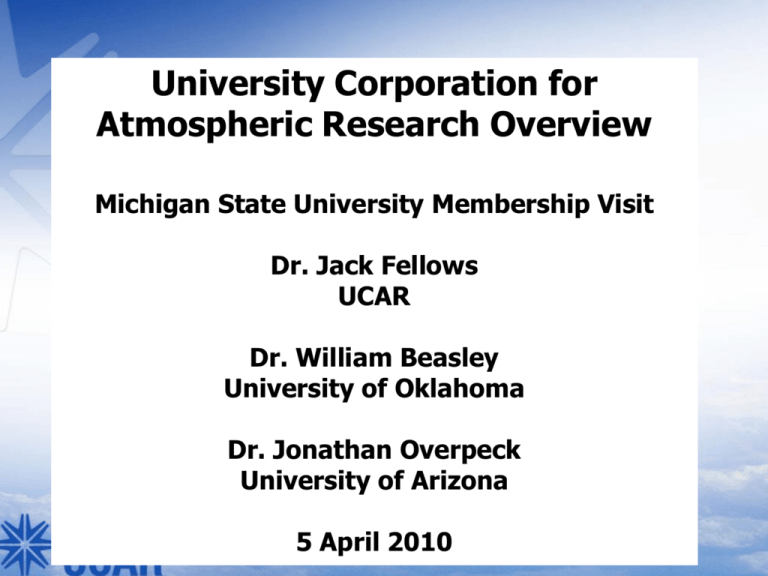
University Corporation for Atmospheric Research Overview Michigan State University Membership Visit Dr. Jack Fellows UCAR Dr. William Beasley University of Oklahoma Dr. Jonathan Overpeck University of Arizona 5 April 2010 Purpose of the Visit and Agenda • Purpose of Visit: On behalf of the UCAR members, help characterize how a university meets the membership criteria by describing: – Who we met – Collaboration with UCAR and NCAR – Faculty research areas – Numbers of grad students over the last five years. – Relevant facilities • Agenda: – What is UCAR? – What does membership in UCAR mean? – What are the collaboration opportunities? UCAR at a Glance • History and Organization. Created in 1960, UCAR is a consortium of 75 North American universities partnered with NSF to oversee a national center (National Center for Atmospheric Research). • Mission. “To serve and provide leadership to the atmospheric science and related communities through research, computing and observational facilities, and education programs that contribute to the betterment of life on earth.” • Community. Created and led by the community and represents one of the most active and broad community partnerships anywhere in science. • Focus. Interdisciplinary science, large computational and observational facilities, huge data sets, high-end numerical models of the sun, atmosphere, oceans, and coupled climate system. Original “Blue Book” reasons for the atmospheric sciences national center: 1. Mount an attack on the atmospheric problems on a scale commensurate with their global nature and importance. 2. That attack requires facilities and technological assistance beyond those available at individual universities. 3. The attack requires talents from various disciplines on a scale not feasible in a university department. 4. The center preserves the natural alliance of research and education without unbalancing the university programs. 2007 Strategic Guidance for the NSF’s Support of the Atmospheric Sciences NRC Board on Atmospheric Sciences and Climate “NCAR/UCAR has been a highly successful center in terms of advancing knowledge of atmospheric science and providing community-based resources. NCAR/UCAR has met many of the objectives laid out in the Blue Book. Since the late 1950s, the atmospheric research enterprise has greatly expanded to its present state where impressive research capabilities exist in the universities, the private sector, and in federal laboratories. Even so, the fundamental rationale for a large national atmospheric sciences center outlined in the Blue Book still remains valid” Support and advance our university consortium Conduct and enable a broad research program in the atmospheric and related sciences Develop and employ increasingly capable observing systems Provide innovative and powerful information technologies, services, and tools Transfer scientific knowledge and new technologies into societal benefits Create, catalyze and support world-class science education programs, resources and communities Develop and engage a diverse workforce Cultivate an environment of organizational excellence where science and education programs thrive Community Developed Strategic Plan: www.ucar.edu/strat_plan 75 UCAR Member Universities (2 representatives each, meet annually) . UCP UCAR Community Programs UCAR’s 73 Member Institutions (1960) University of Alabama in Huntsville University of Houston Pennsylvania State University University of Alaska Howard University Princeton University University at Albany, State University of NY University of Illinois at Urbana-Champaign Purdue University University of Arizona Arizona State University Brown University California Institute of Technology University of California, Berkeley University of California, Davis Iowa State University University of Iowa The Johns Hopkins University University of Maine (2009) University of Maryland University of Rhode Island Rice University Rutgers University Saint Louis University Scripps Institution of Oceanography at UCSD Massachusetts Institute of Technology Stanford University McGill University Texas A & M University University of Miami University of Texas at Austin University of Michigan-Ann Arbor Texas Tech University University of Minnesota University of Toronto University of Missouri Utah State University Naval Postgraduate School University of Utah University of Nebraska Lincoln University of Virginia Nevada System of Higher Education University of Washington University of New Hampshire Washington State University University of Denver New Mexico Institute of Mining and Technology University of Wisconsin- Madison Drexel University New York University Florida State University North Carolina State University Woods Hole Oceanographic Institution Georgia Institute of Technology The Ohio State University University of Wyoming George Mason University (2009) University of Oklahoma Yale University Harvard University Old Dominion University York University University of Hawaii Oregon State University University of California, Irvine University of California, Los Angeles University of Chicago Colorado State University University of Colorado at Boulder Columbia University University of Connecticut Cornell University University of Delaware University of Wisconsin-Milwaukee UCAR Board of Trustees Rana Fine, U Miami, Chairman Richard Anthes, UCAR President Mark Abbott, Oregon State University Steve Ackerman, U Wisconsin Madison Roberta Balstad, Columbia Rosina Bierbaum, U Michigan Fred Carr, Univ of Oklahoma Richard Clark, Millersville University Kerry Cook, U Texas Austin Barbara Feiner, Washington University in St. Louis Efi Foufoula-Georgiou, U Minnesota Dennis Hartman, U Washington Shirley Malcom, AAAS Education and Human Resources Frank Nutter, President, Reinsurance Association of America Robert Palmer (former Chief of Staff, House Science Com) Len Pietrefesa, North Carolina State University Steve Rutledge, Colorado State University Anne Thompson, Penn State Richard Truly (former NASA Administrator, NREL Director) Don Wuebbles, U Illinois UCAR Membership • Community Building and Networking. Work with other Members to shape the course of research and education in the atmospheric and related sciences. Strengthen the field through participation in one of the world’s premier partnerships—the universities, a national laboratory, NSF, and other agencies. Communicate and collaborate with colleagues from around the country and the world. • Governance. Guide UCAR and NCAR programs through governance, planning, and provision of advice – Electing and serving on the Board of Trustees and related committees that provide input on UCAR and NCAR direction and programs. – Participating in the annual meeting and helping to focus that meeting on critical community issues and opportunities – travel paid for two member reps and an Early Career Faculty member – Participate in periodic evaluative community surveys on UCAR and NCAR programs. • Opportunities. Receive regular information on research and education opportunities at UCAR and within the community (community meetings, field campaigns, community initiatives, access to advanced facilities, students’ research, bilateral visits, faculty fellowships, webcasts, etc). UCAR Membership • Advocacy. Receive timely legislative and budget action alerts and support from UCAR that fosters effective interactions with policy makers to strengthen the atmospheric and related sciences. • Human Resources. Be provided with resources to help communitywide recruiting and human resource development (e.g., SOARS, recruiting website and events, salary surveys, diversity building). • Best Practices. Access to innovative financial and management tools and services for the community recognized as best practices by NSF & DOE (e.g., including Measure-up Conferences, HIAPER oversight, program support, etc.) • Membership Responsibilities (via the Member’s Representatives) – Participate in governance activities. – Keep university colleagues informed about UCAR activities. – Bring university perspectives and needs to UCAR’s attention. Collaborations (just a few) Estimated Sustained TFLOPs at NCAR 6 ICESS (IBM P5+/P6) IBM p5-575/HPS (bluevista) 5 IBM Opteron/Linux (pegasus) Sustained TeraFLOPs 4 IBM Opteron/Linux (lightning) ARCS Phase 4 POWER6 IBM POWER4 Federation (thunder) ARCS Phase 3 3 IBM POWER4 Colony (bluesky) ARCS Phase 2 ARCS Phase 1 IBM POWER4 (bluedawn) 2 ICESS blackforest (WH-1) Linux SGI Origin3800/128 POWER5+ IBM POWER3 (blackforest) 1 blackforest (WH-2/NH-2) IBM POWER3 (babyblue) bluevista Jan-99 bluesky blackforest 0 Jan-00 Jan-01 Jan-02 Jan-03 Jan-04 Jan-05 Jan-06 Jan-07 Jan-08 Jan-09 Jan-10 Jan-11 SOARS protégés at work Cascading Scales of Simulation/Prediction Capacity at NCAR Boundary Layer: 10-100 m, Minutes to Hours; The Large Eddy Simulation (LES) Model Regional Climate and Weather: 4-20 km, Hours to Decades; The Nested Regional Climate Model (NRCM) High Impact Weather: 100-1000m, Hours to Days; The Advanced Weather Research and Forecasting Model (WRF) Global Climate and Weather: 50-100 km, Days to Centuries; The Community Climate System Model (CCSM) Holland MMM 1207…Slide 13 ESSL WRF Users Around the Globe 6,050 • Data assimilation options: 3DVar, 4DVar, EnKF, Nudging; • A wide range of physics and chemistry options; • Coupling to land surface and ocean models. • WRF Variants: WRF Chem, NRCM, AHW, WRFVar Operational System at this location At least one Research or Commercial User in this Country Campuses that allow growth, flexibility New chemistry building Research Aviation Facility Mesa Lab ~80,000 visitors annually Center Green Foot Hills Tough Times Ahead? Dollars in Millions www.ucar.edu/td Office of Government Affairs (OGA) Website Visitors NCAR-wide Visitors Program NCAR Hosted 865 Visitors during FY 2006 • • • • • 1-7 days = 507 visitors 8 - 30 days = 164 visitors 31 - 90 days = 98 visitors 91 - 180 days = 37 visitors 180+ days = 59 visitors Sample Visitors Opportunities Undergraduate Leadership Workshop: – College juniors nominated by faculty - convene in Boulder for 5 days – co-sponsored by universities and NCAR – Goals: gain knowledge of multi-disciplinary research, facilities, models, & technology developed and utilized at NCAR Graduate Visitor Program: – Funds graduate student visits to NCAR for 3-12 months to conduct thesis research – NCAR scientist applies on behalf of student and thesis advisor. Funding also available for advisor visit Faculty Fellowship Program: – provides for bilateral visits between NCAR and US universities. Advanced Studies Program Postdoc • The postdoctoral program provides an opportunity for recent Ph.D. scientists to continue to pursue their research interests in atmospheric and related science. • Most fellows develop research projects in collaboration with NCAR scientists, but all are expected to choose their own research directions and are responsible for the design and conduct of their own projects. • ~ seven per year and an appointments for a maximum of two years. • http://www.asp.ucar.edu/pdfp/pd_announcement.php U.S. Atmospheric Science PhDs (1973 to 2002) • 1,991 Total PhDs • 30 Hispanic American PhDs (1.5%) • 17 African American PhDs (.85%) Data from Roman Czujko, AIP Statistical Research Center, with support from the Packard Foundation Significant Opportunities in Atmospheric Research and Science • Four-year, paid summer research internship for undergraduate science, math, engineering, and social science students interested in understanding the atmosphere and using that understanding to improve life on Earth. • The SOARS mission is to broaden participation in the atmospheric and related sciences by engaging students from groups historically underrepresented. • Work with a team of scientists and four mentors on a project matched to your interests and skills. You will perform original research, prepare a scientific paper, and present your research at a colloquium. • http://www.soars.ucar.edu/ SOARS (Significant Opportunities in Atmospheric Research and Science) • 98 protégés have participated in the program since 1996: – 23 are in the STEM workforce, including NOAA and NCAR – 3 have completed their PhDs, 15 are PhD candidates – 32 have earned STEM Masters, 21 currently enrolled – 3 NSF and 3 AMS graduate fellows • 65 conference oral presentations • 113 conference posters • 12 refereed, protégé co-authored papers • 2001 Presidential Award for Excellence in Science, Mathematics, and Engineering Mentoring SOARS Protégés Summer 2005 Questions

